62 start with C start with C
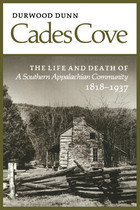
Drawing on a rich trove of documents never before available to scholars, the author sketches the early pioneers, their daily lives, their beliefs, and their struggles to survive and prosper in this isolated mountain community, now within the confines of the Great Smoky Mountains National Park.
In moving detail this book brings to life an isolated mountain community, its struggle to survive, and the tragedy of its demise.
"Professor Dunn provides us with a model historical investigation of a southern mountain community. His findings on commercial farming, family, religion, and politics will challenge many standard interpretations of the Appalachian past."
--Gordon B. McKinney, Western Carolina University.
"This is a fine book. . . . It is mostly about community and interrelationships, and thus it refutes much of the literature that presents Southern Mountaineers as individualistic, irreligious, violent, and unlawful."
—Loyal Jones, Appalachian Heritage.
"Dunn . . . has written one of the best books ever produced about the Southern mountains."
—Virginia Quarterly Review.
"This study offers the first detailed analysis of a remote southern Appalachian community in the nineteenth century. It should lay to rest older images of the region as isolated and static, but it raises new questions about the nature of that premodern community."
—Ronald D Eller, American Historical Review
Not only is his book a worthy addition to the growing body of work recognizing the complexities of southern mountain society; it is also a lively testament to the value of local history and the variety of levels at which it can provide significant enlightenment."
—John C. Inscoe,LOCUS
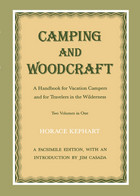
Kephart lived in the Great Smoky Mountains and spent most of his time in the wild. Consequently, he became an expert on all aspects of camp life from living in a semi-permanent lean-to to traveling with only the bare essentials in a backpack. More than simply a hunting or fishing guide, Kephart’s book covers a wide variety of subjects from how to dress game and fish to how to shoot accurately. Every chapter is filled with tips that remain useful even after fifty years of improvements in equipment and technology.
Jim Casada, who has provided an informative introduction to this edition, is professor of history at Winthrop College. He has written numerous articles on sporting figures and outdoor literature and is editor-at-large for Sporting Classics and contributing editor for Fly Fishing Heritage.

In Cannon Mills and Kannapolis, Tim Vanderburg critically examines the rise of the Cannon Mills textile company and the North Carolina community that grew up around it. Beginning with the founding of the company and the establishment of its mill town by James W. Cannon, the author draws on a wealth of primary sources to show how, under Cannon’s paternalism, workers developed a collective identity and for generations accepted the limits this paternalism placed on their freedom. After exploring the growth and maturation of Cannon Mills against the backdrop of World War I and its aftermath, Vanderburg examines the impact of the Great Depression and World War II and then analyzes the postwar market forces that, along with federal policies and unionization, set in motion the industry’s shift from a paternalistic model to bureaucratic authority. The final section of the book traces the decline of paternalism and the eventual decline of Cannon Mills when the death of the founder’s son, Charles Cannon, led to three successive sales of the company. Pillowtex, its final owner, filed for bankruptcy and was liquidated in 2003.
Vanderburg uses Cannon Mills’s intriguing history to help answer some of the larger questions involving industry and paternalism in the postbellum South. Complete with maps and historic photographs, this authoritative, highly readable account of one company and the town it created adds a captivating layer of complexity to our understanding of southern capitalism.
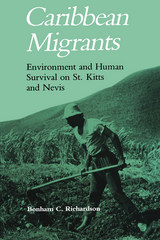
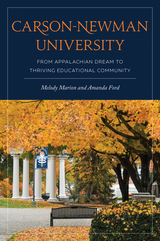
In this expertly told history, Melody Marion and Amanda Ford trace the school’s humble beginnings through two dozen presidents; the turmoil of the American Civil War, Reconstruction, and two world wars; and the contemporary scandals that have plagued the Southern Baptist Convention. Carson-Newman’s history is filled with important players, both courageous and corrupt. Many such players fought tirelessly to grow the campus and maintain a level of excellence at Carson-Newman, but the university’s history is dotted with conflict concerning women’s rights, civil rights, presidents whose questionable actions created firestorms of protest and led to their exits, and modern questions related to its Baptist affiliation.
Additionally, Carson-Newman University owes much to its Appalachian heritage, and in an excellent final chapter the authors unpack Carson-Newman’s regional identity past and present. Education in Appalachia historically has fallen behind national standards, but from its start as a seminary through its gender-segregated college days to the integrated orange-and-blue Eagles we know today, the university, with its presidents and academic body has been an agent of demonstrable gain for its students and the region. Today, as new chapters in Carson-Newman’s history are being opened, this text will serve as a record of tradition, world-class education, and lifelong learning within a Christian setting.

Businessman, politician, broadcasting personality, and newspaper publisher, Cas Walker (1902–1998) was, by his own estimation, a “living legend” in Knoxville for much of the twentieth century. Renowned for his gravelly voice and country-boy persona, he rose from blue-collar beginnings to make a fortune as a grocer whose chain of supermarkets extended from East Tennessee into Virginia and Kentucky. To promote his stores, he hosted a local variety show, first on radio and then TV, that advanced the careers of many famed country music artists from a young Dolly Parton to Roy Acuff, Chet Atkins, and Bill Monroe. As a member of the Knoxville city council, he championed the “little man” while ceaselessly irritating the people he called the “silk-stocking crowd.”
This wonderfully entertaining book brings together selections from interviews with a score of Knoxvillians, various newspaper accounts, Walker’s own autobiography, and other sources to present a colorful mosaic of Walker’s life. The stories range from his flamboyant advertising schemes—as when he buried a man alive outside one of his stores—to memories of his inimitable managerial style—as when he infamously canned the Everly Brothers because he didn’t like it when they began performing rock ’n’ roll. Further recollections call to mind Walker’s peculiar brand of bare-knuckle politics, his generosity to people in need, his stance on civil rights, and his lifelong love of coon hunting (and coon dogs). The book also traces his decline, hastened in part by a successful libel suit brought against his muckraking weekly newspaper, the Watchdog.
It’s said that any Knoxvillian born before 1980 has a Cas Walker story. In relating many of those stories in the voices of those who still remember him, this book not only offers an engaging portrait of the man himself and his checkered legacy, but also opens a new window into the history and culture of the city in which he lived and thrived.
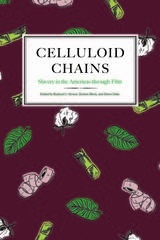
Featuring a variety of disciplinary perspectives and analytical approaches, Celluloid Chains is the most comprehensive volume to date on films about slavery. This collection examines works from not only the United States but elsewhere in the Americas, and it attests to slavery’s continuing importance as a source of immense fascination for filmmakers and their audiences.
Each of the book’s fifteen original essays focuses on a particular film that directly treats the enslavement of Africans and their descendants in the New World. Beginning with an essay on the Cuban film El otro Francisco (1975), Sergio Giral’s reworking of a nineteenth-century abolitionist novel, the book proceeds to examine such works as the landmark miniseries Roots (1977), which sparked intense controversy over its authenticity; Werner Herzog’s Cobra Verde (1987), which raises questions about what constitutes a slavery film; Guy Deslauriers’s Passage du milieu (1999), a documentary-style reconstruction of what Africans experienced during the Middle Passage; and Steve McQueen’s Oscar-winning 12 Years a Slave (2013), which embodies the tensions between faithfully adapting a nineteenth-century slave narrative and bending it for modern purposes.
Films about slavery have shown a special power to portray the worst and best of humanity, and Celluloid Chains is an essential guide to this important genre.
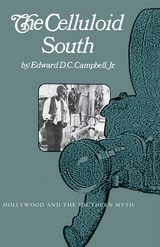
The “southern” – as much a Hollywood genre as the “western” – is the subject of The Celluloid South. For decades the film industry, to provide profit-making entertainment, offered the public movies that neither raised difficult issues nor offended a majority of the ticket-buyers. As a result, Hollywood romanticized the south, particularly the antebellum era, in hundreds of films like Uncle Tom’s Cabin, Gone With the Wind, Birth of a Nation, and Jezebel. During the 1920’s and especially the Depression, the “moonlight and magnolia” romances increased to such an extent that Hollywood has been struggling since the late forties to rid films of the traditional images of the “southern.”
In his exploration of the “southern,” Edward D.C. Campbell, Jr. examines the film plots and images – their social, literary, and historical origins, and their impact on the creation of a popular mythology of the south. The unrealistic but seemingly harmless characterizations of a planter society, and agricultural economy, and especially slavery have hindered the region’s self-assessment and warped the nation’s perspective on race.
Campbell looks beyond the productions themselves, however, to advertising techniques and the reactions of the viewers and reviewers in his examination of the “southern,” its popularity and its decline, and its influence of the public’s conception of history, contemporary conditions, and black/white relations.
The Celluloid South is not a study of film per se, but of film as a reflection of society and the ramifications inherent in popular entertainment. Readers interested in southern history, popular culture, or cinema studies, as well as movie fans, will find The Celluloid South a fascinating look at Hollywood’s development of the southern myth. Thirty-one film stills illustrate the text.
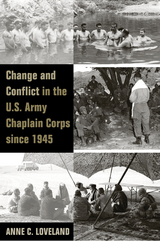
to conducting chapel activities on military installations and providing moral and spiritual
support on the battlefield, they conduct memorial services for fallen soldiers, minister
to survivors, offer counsel on everything from troubled marriages to military bureaucracy,
and serve as families’ points of contact for wounded or deceased soldiers—all while
risking the dangers of combat alongside their troops. In this thoughtful study, Anne C.
Loveland examines the role of the army chaplain since World War II, revealing how the
corps has evolved in the wake of cultural and religious upheaval in American society and
momentous changes in U.S. strategic relations, warfare, and weaponry.
From 1945 to the present, Loveland shows, army chaplains faced several crises that
reshaped their roles over time. She chronicles the chaplains’ initiation of the Character
Guidance program as a remedy for the soaring rate of venereal disease among soldiers in
occupied Europe and Japan after World War II, as well as chaplains’ response to the challenge
of increasing secularism and religious pluralism during the “culture wars” of the
Vietnam Era.“Religious accommodation,” evangelism and proselytizing, public prayer,
and “spiritual fitness”provoked heated controversy among chaplains as well as civilians in
the ensuing decades. Then, early in the twenty-first century, chaplains themselves experienced
two crisis situations: one the result of the Vietnam-era antichaplain critique, the
other a consequence of increasing religious pluralism, secularization, and sectarianism
within the Chaplain Corps, as well as in the army and the civilian religious community.
By focusing on army chaplains’ evolving, sometimes conflict-ridden relations with
military leaders and soldiers on the one hand and the civilian religious community on the
other, Loveland reveals how religious trends over the past six decades have impacted the
corps and, in turn, helped shape American military culture.
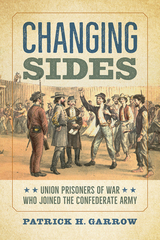
Toward the end of the American Civil War, the Confederacy faced manpower shortages, and the Confederate Army, following practices the Union had already adopted, began to recruit soldiers from their prison ranks. They targeted foreign-born soldiers whom they thought might not have strong allegiances to the North. Key battalions included the Brooks Battalion, a unit composed entirely of Union soldiers who wished to join the Confederacy and were not formally recruited; Tucker’s Regiment and the 8th Battalion Confederate Infantry recruited mainly among Irish, German, and French immigrants.
Though the scholarship on the Civil War is vast, Changing Sides represents the first entry to investigate Union POWs who fought for the Confederacy, filling a significant gap in the historiography of Civil War incarceration. To provide context, Patrick Garrow traces the history of the practice of recruiting troops from enemy POWs, noting the influence of the mostly immigrant San Patricios in the Mexican-American War. The author goes on to describe Confederate prisons, where conditions often provided ample incentive to change sides. Garrow’s original archival research in an array of archival records, along with his archaeological excavation of the Confederate guard camp at Florence, South Carolina, in 2006, provide a wealth of data on the lives of these POWs, not only as they experienced imprisonment and being “galvanized” to the other side, but also what happened to them after the war was over.
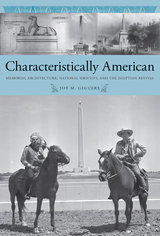
Far more than a study of Egyptian revivalism, this book examines the Egyptian style of commemoration from the rural cemetery to national obelisks to the Sphinx at Mount Auburn Cemetery. Giguere argues that Americans adopted Egyptian forms of commemoration as readily as other neoclassical styles such as Greek revivalism, noting that the American landscape is littered with monuments that define the Egyptian style’s importance to American national identity. Of particular interest is perhaps America’s greatest commemorative obelisk: the Washington Monument. Standing at 555 feet high and constructed entirely of stone—making it the tallest obelisk in the world—the Washington Monument represents the pinnacle of Egyptian architecture’s influence on America’s desire to memorialize its national heroes by employing monumental forms associated with solidity and timelessness. Construction on the monument began in 1848, but controversy over its design, which at one point included a Greek colonnade surrounding the obelisk, and the American Civil War halted construction until 1877. Interestingly, Americans saw the completion of the Washington Monument after the Civil War as a mending of the nation itself, melding Egyptian commemoration with the reconstruction of America.
As the twentieth century saw the rise of additional commemorative obelisks, the Egyptian Revival became ensconced in American national identity. Egyptian-style architecture has been used as a form of commemoration in memorials for World War I and II, the civil rights movement, and even as recently as the 9/11 remembrances. Giguere places the Egyptian style in a historical context that demonstrates how Americans actively sought to forge a national identity reminiscent of Egyptian culture that has endured to the present day.

have ignited contentious global debates about alternative energy technologies. In this lucid,
balanced book, Rody Johnson investigates the development and deployment of one
such technology—wind power—and, in particular, the ways in which a heated battle over
that energy source played out in an Appalachian community.
Johnson’s wide-ranging account examines the history of wind power; its capacity and
output in comparison to such sources as fossil fuels, other renewables, and nuclear energy;
the infrastructural challenges of transmitting electricity from wind farms to end users;
global efforts to curb carbon emissions, including the Kyoto treaty; the role of public
policy, government subsidies, and tax breaks; and the differences and similarities between
wind power regimes in the United States and Europe.
Interwoven throughout this discussion is the compelling narrative of how, beginning
in 2005, the proposed construction of a wind farm along mountain ridges in Greenbrier
County, West Virginia, pitted locals against each other—a story that puts a human face on
the arguments about wind power’s promise of clean, renewable energy and its potentially
negative effects, including bird and bat kills, a disfigured natural landscape, and noise
pollution. Drawing on countless hours he spent attending public meetings and interviewing
those on both sides of the issue, Johnson not only pictures the Greenbrier County
struggle in illuminating detail but also makes valuable comparisons between it and similarly
pitched battles in another West Virginia county, where a wind farm had already been
built, and in Florida, where plans to erect beachside wind turbines next to a nuclear plant
faltered.
Concluding with a thoughtful, realistic assessment of a 2012 study suggesting that
the country has the capability of receiving 80 percent of its electrical generation from
renewables by 2050, Chasing the Wind makes a vital contribution to the ongoing dialogue
regarding America’s energy challenges and what is likely required to meet them.
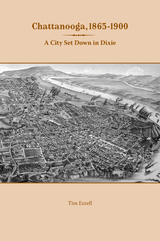
After reviewing Chattanooga’s wartime experience, Ezzell chronicles political and economic developments in the city over the next two generations. White Republicans, who dominated municipal government thanks to the support of Chattanooga’s large African American population, clashed repeatedly with Democrats, who worked to “redeem” the city from Republican rule and restore “responsible,” “efficient” government. Ezzell shows that, despite the efforts by white Democrats to undermine black influence, black Chattanoogans continued to wield considerable political leverage into the 1890s.
On the economic front, an extensive influx of northern entrepreneurs and northern capital into postwar Chattanooga led to dynamic if unstable growth. Ezzell details the city’s efforts to compete with Birmingham as the center of southern iron and steel production. At times, this vision was within reach, but these hopes faded by the 1890s, and Chattanooga grew into something altogether different: not northern, not southern, but something peculiar “set down in Dixie.”
Although Chattanooga never reached its Yankee boosters’ ideal of “a northern industrial city at home in the southern hills,” Ezzell demonstrates that it forged a legacy of resilience and resourcefulness that continues to serve the community to the present day.
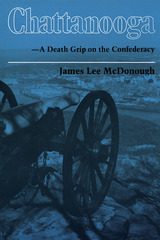
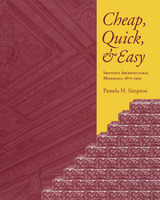
As Simpson shows in fascinating detail, rockface concrete blocks, pressed metal imitations of stone, linoleum “marble” and “parquet,” and embossed wall coverings made available to the masses a host of ornamental effects that only the wealthy could previously have afforded. But, she notes, wherever these new materials appeared, a heated debate over the appropriateness of imitation followed. Were these materials merely tasteless shams? Or were they economical, durable alternatives that democratically extended the possibilities of ornamentation?
Simpson devotes chapters to each of the various ornamental materials, considering its precursors, invention, production, and distribution. In her final chapter, she traces the history of the aesthetic debate over imitation and analyzes the social meaning of the materials. Far from being “bad taste,” she concludes, these new ornamental forms reflected modernism, democracy, and progress—some of the most deeply held values of the period.
The Author: Pamela H. Simpson is Ernest Williams II Professor of Art History at Washington and Lee University. The author of numerous articles and exhibition catalogs, she is co-author (with Royster Lyle) of The Architecture of Historic Lexington. She was president, for the 1997–99 term, of the Vernacular Architecture Forum.

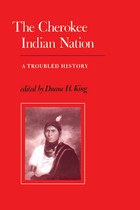
"Any serious historian or reader of Native American literature must add Dr. King's classic book to their collection to appreciate its dimension and quality of research reporting."
—Don Shadburn, Forsyth County News (Cummings, GA)

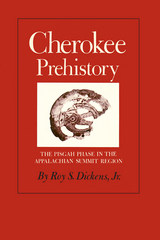
After a century of archaeological research in the Southeastern United States, there are still areas about which little is known. Surprisingly, one of these areas in the Appalachian Summit, which in historic times was inhabited by the Cherokee people whose rich culture and wide influence made their name commonplace in typifying Southeastern Indians. The culture of the people who preceded the historic Cherokees was no less rich, and their network of relationships with other groups no less wide. Until recently, however, the prehistoric cultural remains of the Southern Appalachians had received only slight attention.
Archaeological sites in the Appalachians usually do not stand out dramatically on the landscape as do the effigy mounds of the Ohio Valley and the massive platform mounds of the Southeastern Piedmont and Mississippi Valley. Prehistoric settlements in the Southern Appalachians lay in the bottomlands along the clear, rocky rivers, hidden in the folds of the mountains. Finding and investigating these sites required a systematic approach. From 1964 to 1971, under the direction of Joffre L. Coe, the Research Laboratories of Anthropology at the University of North Carolina, Chapel Hill, conducted an archaeological project that was designed to investigate the antecedents of the historic Cherokees in the Appalachian Summit, and included site surveys over large portions of the area and concentrated excavations at several important sites in the vicinity of the historic Cherokee Middletowns.
One result of the Cherokee project is this book, the purpose of which is to present an initial description and synthesis of a late prehistoric phase in the Appalachian Summit, a phase that lasted from the beginnings of South Appalachian Mississippian culture to the emergence of identifiable Cherokee culture. At various points Professor Dickens draws these data into the broader picture of Southeastern prehistory, and occasionally presents some interpretations of the human behavior behind the material remains, however, is to make available some new information on a previously unexplored area. Through this presentation Cherokee Prehistory helps to provide a first step to approaching, in specific ways, the problems of cultural process and systemics in the aboriginal Southeast.
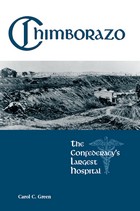
Organized by Dr. James Brown McCaw, Chimborazo was an innovative hospital with well-trained physicians, efficient stewards, and a unique supply system. Physicians had access to the latest medical knowledge and specialists in Richmond. The hospital soon became a model for other facilities. The hospital’s clinical reputation grew as it established connections with the Medical College of Virginia and hosted several drug and treatment trials requested by the Confederate Medical Department.
In fascinating detail, Chimborazo recounts the issues, trials, and triumphs of a Civil War hospital. Based on an extensive study of hospital and Confederate Medical Department records found at the National Archives, along with other primary sources, the study includes information on the patients, hospital stewards, matrons, and slaves who served as support staff. Since Chimborazo was designated as an independent army post, the book discusses other features of its organization, staff, and supply system as well. This careful examination describes the challenges facing the hospital and reveals the humanity of those who lived and worked there.
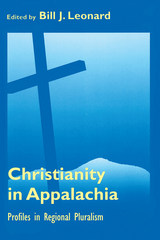
Profiling the prominent Christian traditions in southern Appalachia, this book brings together contributions by twenty scholars who have long studied the religious practices found in the region’s cities, small towns, and rural communities. These authors provide insights into not only the independent mountain churches that are strongly linked to local customs but also the mainline and other religious bodies that have a significant presence in Appalachia but are not strictly associated with it. The essays explore the nature of ministry within these various churches, show the impact of broader culture on religion in the region, and consider the question of whether previously isolated, tradition-based churches can retain their distinctiveness in a changing world.
One group of chapters focuses on elements of mountain religion as seen in the beliefs and practices of mountain Holiness folk, serpent handlers, and various Baptist traditions. Later chapters review the history and activities of other denominations, including Southern Baptist, Presbyterian, Wesleyan/Holiness, Church of God, and Roman Catholic. Also considered are the economic history of the region, popular religiosity, and the role of church-affiliated colleges. Taken together, these essays offer a richly nuanced understanding of Christianity in Appalachia.
The Editor: Bill J. Leonard is dean of the Divinity School at Wake Forest University. His other books include Out of One, Many: American Religion and American Pluralism and God's Last and Only Hope: The Fragmentation of the Southern Baptist Convention.
The Contributors: Monica Kelly Appleby, Donald N. Bowdle, Mary Lee Daugherty, Melvin E. Dieter, Howard Dorgan, Anthony Dunnavant, Gary Farley, Samuel S. Hill, Loyal Jones, Helen Lewis, Charles H. Lippy, Bill J. Leonard, Deborah Vansau McCauley, Lou F. McNeil, Marcia Clark Myers, Bennett Poage, Ira Read, James Sessions, Barbara Ellen Smith, H. Davis Yeuell.
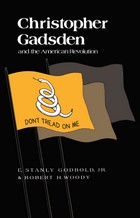
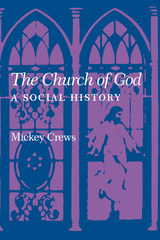
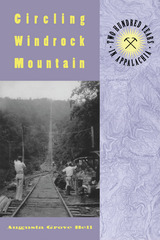
The stories Augusta Bell recounts take us from Oliver Springs—which had its origins in the grist mill Moses Winters built in 1799 and which later became a “boom town” with a fashionable resort hotel—to places like New River Valley, Graves Gap, and Duncan Flats. She depicts the everyday lives of the mountain people as well as the extraordinary events that sometimes shattered those lives—such as the Coal Creek War of 1891–93, in which miners squared off against state militia, and the two mine explosions that came a few years later, sealing up 268 men deep inside the mountain. Bell also tells of happier times, as when the famous Windrock Mine opened above Oliver Springs in 1909.
Tapping a rich lode of folklore and oral tradition, along with other historical sources, Circling Windrock Mountain offers a view of Appalachian life that defies old stereotypes. Far from being static, the communities described here saw an amazing variety of changes to which they adapted with resilience and ingenuity.
The Author: Augusta Grove Bell, a writer who now lives in Charlotte, North Carolina, has been a newspaper reporter and teacher. From 1958 to 1970, she lived in Anderson County, Tennessee, where she worked for the Oak Ridger and wrote feature stories that form much of the basis for this book.
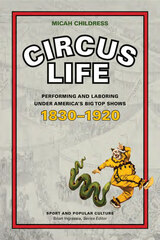
The circus has long been a subject of fascination for many, as evidenced by the millions of Americans that have attended circus performances over many decades since 1870, when the circus established itself as a truly unique entertainment enterprise. Yet the few analyses of the circus that do exist have only examined the circus as its own closed microcosm—the “circus family.” Circus Life, on the other hand, places circus employees in the larger context of the history of US workers and corporate America. Focusing on the circus as a business-entertainment venture, Childress pushes the scholarship on circuses to new depths, examining the performers, managers, and laborers’ lives and how the circus evolved as it grew in popularity over time. Beginning with circuses in the antebellum era, Childress examines changes in circuses as gender balances shifted, industrialization influenced the nature of shows, and customers and crowds became increasingly more middle-class.
As a study in sport and social history, Childress’s account demonstrates how the itinerant nature of the circus drew specific types of workers and performers, and how the circus was internally in constant upheaval due to the changing profile of its patrons and a changing economy.
MICAH D. CHILDRESS received his PhD in history from Purdue University and currently works as a Realtor® in Grand Rapids, Michigan. His articles have appeared in Popular Entertainment Studies and American Studies.

Ethel Thomas Herold (1896–1988) was an ordinary person caught up in extraordinary
circumstances—a woman whose sense of patriotic duty took her from small-town Wisconsin to the Philippines in 1922. There, with but a couple of brief interruptions, she would spend the next thirty-seven years, including three in a Japanese internment camp during World War II. In Citizen of Empire, Theresa Kaminski uses Ethel’s experiences of war and imperialism to explore a unique example of how those enormous forces helped shape Americans’ notions of citizenship and patriotism in the first half of the twentieth century.
As Kaminski’s absorbing narrative reveals, Ethel’s views of active patriotism began to form early on when her oldest brother became a schoolteacher in the Philippines in 1901 at the end of the Spanish-American War. After college and marriage, Ethel and her husband Elmer Herold went to the islands to teach in the public schools—a way, in her view, of spreading American ideals abroad. She quit teaching in 1927 to start a family but continued to support U.S. imperialism through her colonial household and club work. Her comfortable expatriate life fell apart, however, when the Japanese attacked the Philippines in 1941: the colonial elite were now powerless prisoners. After the war, wishing to help the people who had supported them during the occupation, Ethel and Elmer Herold stayed in the islands, but after Philippine independence came in 1946, they increasingly found themselves strangers in a place they had long called home. In 1959 the couple returned to Wisconsin, where Ethel remained politically active and saw the solution
to America’s Cold War problems in the conservative wing of the Republican Party.
Ethel Thomas Herold was a woman of forceful personality. Marked most notably by her strongly held views on patriotism and citizenship, her transpacific life offers a remarkable
instance of how the personal and political came together during the “American century.”
Theresa Kaminski is professor of history at the University of Wisconsin–Stevens Point and the author of Prisoners in Paradise: American Women in the Wartime South Pacific.
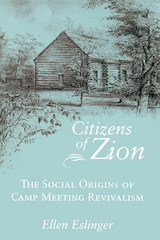
To trace the origins of the camp meeting, Ellen Eslinger follows Kentucky's development from its initial settlement in 1775 to the eve of the Great Revival. She describes how a region first characterized by border warfare during the Revolution quickly cast off its frontier beginnings. Even so, she demonstrates, settlers found it difficult to cope with challenges posed by economic competition, political partisanship, and cultural conflict. In this time of uncertainty, camp meetings brought a restored sense of community attachment, merging Christian and republican ideals to create a new model of American society.
Citizens of Zion does more than explain a particular instance of religious revivalism; it explores the creation of a new form of worship that enabled people to relate more comfortably to a changing society through an intense collective experience. It explains how early camp meeting revivalism—as exemplified by the Cane Ridge gathering—differed significantly from both earlier evangelical forms and later manifestations. Camp meeting revivalism, Eslinger shows, eventually came to reflect the emerging liberal culture, but its early years reveal it as an important mechanism for reintegration into a rapidly transforming world.
The Author: Ellen Eslinger is associate professor of history at DePaul University.
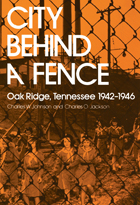
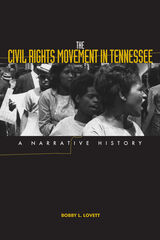
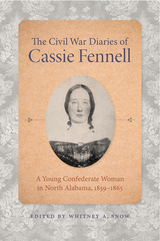
Born near Guntersville, Alabama, Catherine (Cassie) Fennell was nineteen when the Civil War began. Starting with her time at a female academy in Washington, DC, the diaries continue through the war’s end and discuss civilian experiences in Alabama and the Tennessee Valley. Fennell believed that by keeping a diary she made a small contribution to the war effort and history itself.
Fennell was fairly well off and highly educated, moving easily in very elite social circles. Most of her relatives were staunch Confederates, and the war took its toll, with multiple members of her family killed or captured. As Fennell recounts the consequences of war—the downward spiral of the family fortune, the withering of hope at news from the battlefront, and the general uncertainty of civilian life in the South—her diaries constitute one of the few contemporaneous records of north Alabama, including the shelling and burning of Guntersville, which has been poorly documented in the historiography of the Civil War. While the first diary is written as a private reflection, the war journals are well researched and rely on extensive familiarity with local newspapers and seem like they are intended for the eyes of later generations.
Ultimately, these diaries amount to a social history of the war years, in a specific region where scholars have recovered relatively few firsthand accounts, and editor Whitney Snow’s compilation adds to the now growing genre of women’s Civil War diaries. Insightful and engrossing, The Civil War Diaries of Cassie Fennell is a compelling portrait of a privileged young woman who suffered devastating losses for her ardent support of a Confederate nation.
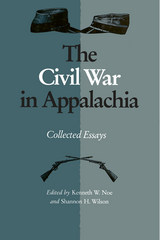
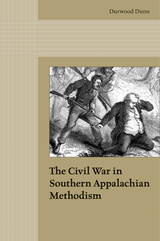
In many important respects, the actual Civil War that began in 1861 unveiled an internal civil war within the Holston Conference of the Methodist Episcopal Church, South—comprising churches in southwestern Virginia, eastern Tennessee, western North Carolina, and a small portion of northern Georgia—that had been waged surreptitiously for the previous five decades. This work examines the split within the Methodist Church that occurred with mounting tensions over the slavery question and the rise of the Confederacy. Specifically, it looks at how the church was changing from its early roots as a reform movement grounded in a strong local pastoral ministry to a church with a more intellectual, professionalized clergy that often identified with Southern secessionists.
The author has mined an exhaustive trove of primary sources, especially the extensive, yet often-overlooked minutes from frequent local and regional Methodist gatherings. He has also explored East Tennessee newspapers and other published works on the topic. The author’s deep research into obscure church records and other resources results not only in a surprising interpretation of the division within the Methodist Church but also new insights into the roles of African Americans, women, and especially lay people and local clergy in the decades prior to the war and through its aftermath. In addition, Dunn presents important information about what the inner Civil War was like in East Tennessee, an area deeply divided between Union and Confederate sympathizers.
Students and scholars of religious history, southern history, and Appalachian studies will be enlightened by this volume and its bold new way of looking at the history of the Methodist Church and this part of the nation.
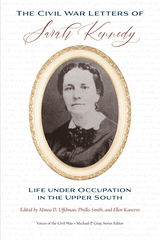
At the outbreak of the Civil War, Sarah Kennedy watched as her husband, D.N., left for Mississippi, leaving her alone to care for their six children and control their slaves in a large home in downtown Clarksville, Tennessee. D. N. Kennedy left to aid the Confederate Treasury Department. He had steadfastly supported secession and helped recruit local boys for the Confederate army. The Civil War Letters of Sarah Kennedy: Life under Occupation in the Upper South showcases the letters Sarah wrote to her husband during their time apart, offering readers an inside look at life on the home front during the Civil War through the eyes of a slave-owning, town-dwelling wife and mother.
Featuring fifty-two of Sarah Kennedy’s letters to her husband from August 16, 1862, to February 20, 1865, this important collection chronicles Sarah Kennedy’s personal struggles during the Civil War years, from periods of illness to lack of consistent contact with her husband and everything in between. Her love and devotion to her family is apparent in each letter, contrasting deeply with her resentment and harsh treatment toward her enslaved people as Emancipation swept through Clarksville. A useful volume to Civil War historians and women’s history scholars alike, The Civil War Letters of Sarah Kennedy pulls back the curtain on upper-middle-class family life and social relations in a mid-sized Middle Tennessee town during the Civil War and reveals the slow demise of slavery during the Union occupation.
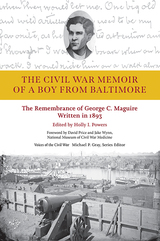
Fourteen-year-old George Maguire was eager to serve the Union when his home state, Maryland, began raising regiments for the coming conflict. Too young to join, he became a “mascot” for the Fifth Maryland Infantry Regiment, organized in September 1861. Although he never formally enlisted or carried a weapon, Maguire recounts several pivotal events in the war, including the sea battle of the Monitor vs. Merrimac, Peninsula Campaign action, and the Battle of Antietam.
During middle age, Maguire recorded his memoir—one of the few from a Maryland unit—providing a distinctive blend of the adventures of a teenage boy with the mature reflection of a man. His account of the Peninsula Campaign captures the success of the mobilization of forces and confirms the existing historical record, as well as illuminating the social structure of camp life. Maguire’s duties evolved over time, as he worked alongside army surgeons and assisted his brother-in-law (a “rabid abolitionist” and provost marshal of the regiment). This experience qualified him to work at the newly constructed Thomas Hicks United States General Hospital once he left the regiment in 1863; his memoir describes the staffing hierarchy and the operating procedures implemented by the Army Medical Corps at the end of the war, illuminated with the author’s own sketches of the facility.
From the Pratt Street riot in Baltimore to a chance encounter with Red Cross founder Clara Barton to a firsthand view of Hicks Hospital, this sweeping yet brief memoir provides a unique opportunity to examine the experiences of a child during the war and to explore the nuances of memory. Beyond simply retelling the events as they happened, Maguire’s memoir is woven with a sense of remorse and resolve, loss and fear, and the pure wonderment of a teenage boy accompanying one of the largest assembled armies of its day.
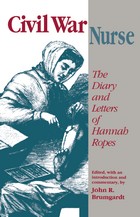
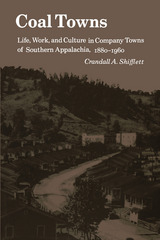
From their own point of view, mining families left behind a life of hard labor and drafty weatherboard homes. With little time for such celebrated arts as tale-telling and quilting, preindustrial mountain people strung more beans than dulcimers. In addition, the rural population was growing, and farmland was becoming scarce. What the families recall about the coal towns contradicts the popular image of mining life. Most miners did not owe their souls to the company store, and most mining companies were not unusually harsh taskmasters. Former miners and their families remember such company benefits as indoor plumbing, regular income, and leisure activities. They also recall the United Mine Workers of America as bringing not only pay raises and health benefits but work stoppages and violent confrontations.
Far from being mere victims of historical forces, miners and their families shaped their own destiny by forging a new working-class culture out of the adaptation of their rural values to the demands of industrial life. This new culture had many continuities with the older one. Out of the closely knit social ties they brought from farming communities, mining families created their own safety net for times of economic downturn. Shifflett recognizes the dangers and hardships of coal-town life but also shows the resilience of Appalachian people in adapting their culture to a new environment.
Crandall A. Shifflett is an associate professor of history at Virginia Polytechnic Institute and State University.
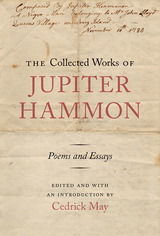
Cedrick May’s The Collected Works of Jupiter Hammon offers a complete look at the literary achievements of one of the founders of African American literature. Born into slavery on the Lloyd plantation in 1711, Jupiter Hammon became the first African American writer to be published in the present-day United States at the age of forty-nine. It has been decades since a collection of Hammon’s work has appeared, and May’s intensive research has yielded two additional poems, adding new layers to his works and life that, until now, have gone unexplored.
The most comprehensive volume on Hammon’s works to date, The Collected Works of Jupiter Hammon carefully reconstructs the historical, political, social, and religious contexts that shaped his essays and poems throughout the late eighteenth century. This attentive reconstruction, which takes full account of Hammon’s prose works as well as his more well-known poetry, gives readers a radical re-reading of Hammon as a much more complex and intellectually curious commentator on his historical and political period, while providing ample evidence of his literary importance and artistic integrity. Cedrick May’s fresh presentation and insightful reevaluation of Hammon’s life and writings will change the way Hammon is studied and appreciated among literary scholars and readers alike. This edition will become the definitive one for many years to come.

Cedrick May’s The Collected Works of Jupiter Hammon offers a complete look at the literary achievements of one of the founders of African American literature. Born into slavery on the Lloyd plantation in 1711, Jupiter Hammon became the first African American writer to be published in the present-day United States at the age of forty-nine. It has been decades since a collection of Hammon’s work has appeared, and May’s intensive research has yielded two additional poems, adding new layers to his works and life that, until now, have gone unexplored.
The most comprehensive volume on Hammon’s works to date, The Collected Works of Jupiter Hammon carefully reconstructs the historical, political, social, and religious contexts that shaped his essays and poems throughout the late eighteenth century. This attentive reconstruction, which takes full account of Hammon’s prose works as well as his more well-known poetry, gives readers a radical re-reading of Hammon as a much more complex and intellectually curious commentator on his historical and political period, while providing ample evidence of his literary importance and artistic integrity. Cedrick May’s fresh presentation and insightful reevaluation of Hammon’s life and writings will change the way Hammon is studied and appreciated among literary scholars and readers alike. This edition will become the definitive one for many years to come.
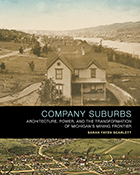
Michigan’s Keweenaw Peninsula juts into Lake Superior, pointing from the western Upper Peninsula toward Canada. Native peoples mined copper there for at least five thousand years, but the industrial heyday of the “Copper Country” began in the late nineteenth century, as immigrants from Cornwall, Italy, Finland, and elsewhere came to work in mines largely run from faraway cities such as New York and Boston. In those cities, suburbs had developed to allow wealthier classes to escape the dirt and grime of the industrial center. In the Copper Country, however, the suburbs sprang up nearly adjacent to mines, mills, and coal docks.
Sarah Fayen Scarlett contrasts two types of neighborhoods that transformed Michigan’s mining frontier between 1875 and 1920: paternalistic company towns built for the workers and elite suburbs created by the region’s network of business leaders. Richly illustrated with drawings, maps, and photographs, Company Suburbs details the development of these understudied cultural landscapes that arose when elites began to build housing that was architecturally distinct from that of the multiethnic workers within the old company towns. They followed national trends and created social hierarchies in the process, but also, uniquely, incorporated pre-existing mining features and adapted company housing practices. This idiosyncratic form of suburbanization belies the assumption that suburbs and industry were independent developments.
Built environments evince interrelationships among landscapes, people, and power. Scarlett’s work offers new perspectives on emerging national attitudes linking domestic architecture with class and gender identity. Company Suburbs complements scholarship on both industrial communities and early suburban growth, increasing our understanding of the ways hierarchies associated with industrial capitalism have been built into the shared environments of urban areas as well as seemingly peripheral American towns.
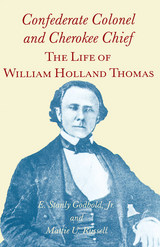
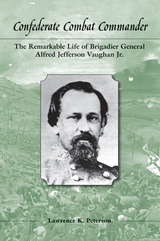
In Confederate Combat Commander, Lawrence K. Peterson explores the life of this unheralded yet important rebel officer before, during, and after his military service. A graduate of Virginia Military Institute, Vaughan initially commanded the Thirteenth Tennessee Infantry Regiment, and later Vaughan’s Brigade. He served in the hard-fought battles of the western area of operations in such key confrontations as Shiloh, Perryville, Stones River, Chickamauga, Chattanooga, and the Atlanta Campaign.
Tracing Vaughan’s progress through the war and describing his promotion to general after his commanding officer was mortally wounded, Peterson describes the rise and development of an exemplary military career, and a devoted fighting leader. Although Vaughan was beloved by his troops and roundly praised at the time—in fact, negative criticism of his orders, battlefield decisions, or personality cannot be found in official records, newspaper articles, or the diaries of his men—Vaughan nevertheless served in the much-maligned Army of Tennessee. This book thus assesses what responsibility—if any—Vaughan bore for Confederate failures in the West.
While biographies of top-ranking Civil War generals are common, the stories of lower-level senior officers such as Vaughan are seldom told. This volume provides rare insight into the regimental and brigade-level activities of Civil War commanders and their units, drawing on a rich array of privately held family histories, including two written by the general himself.
Lawrence K. Peterson, a retired airline pilot, worked as a National Park Service ranger and USAF officer. He is the great-great grandson of Brigadier General Alfred Jefferson Vaughan Jr.
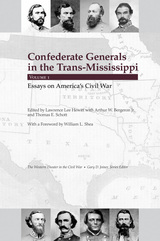
Although the Trans-Mississippi has long been considered a dumping ground for failed generals from other regions, the essays presented here demolish that myth, showing instead that, with a few notable exceptions, Confederate commanders west of the Mississippi were homegrown, not imported, and compared well with their more celebrated peers elsewhere. With its virtually nonexistent infrastructure, wildly unpredictable weather, and few opportunities for scavenging, the Trans-Mississippi proved a challenge for commanders on both sides of the conflict. As the contributors to this volume demonstrate, only the most creative minds could operate successfully in such an unforgiving environment.
While some of these generals have been the subjects of larger studies, others, including Generals Holmes, Parsons, and Churchill, receive their first serious scholarly attention in these pages. Clearly demonstrating the independence of the Trans-Mississippi and the nuances of the military struggle there, while placing both the generals and the theater in the wider scope of the war, these eight essays offer valuable new insight into Confederate military leadership and the ever-vexing questions of how and why the South lost this most defining of American conflicts.
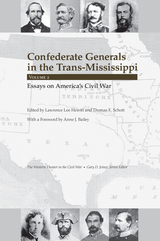
Contrary to popular belief, the Trans-Mississippi did not serve as a dumping ground for generals who had failed in Virginia. Instead, the majority of generals who served in the region were homegrown and faced challenges unknown to their counterparts in the East—expansive territory, few men, and limited transportation for the meager supplies available. Superior Union numbers in the West, however, did not guarantee Union victory. As these essays show, southern generals often beat themselves because of personal failings or an inability to work together. Sterling Price and Ben McCulloch refused to cooperate, Henry Sibley combined alcoholism with cowardice, and the able French-born Prince de Polignac faced language barriers. The war ended before Joseph Brent, a visionary regarding tank warfare, could make his name as a brigadier, and “Prince John” Magruder’s achievements in Texas remain overshadowed by his earlier career in Virginia. The Cajun Alfred Mouton, a superior leader, died on a battlefield in his native Louisiana, while Mosby Parsons survived the war only to be murdered by Mexican cavalry. While some of these generals breathed life into the Confederacy, others hastened its downfall.
By chronicling the lives and careers of these eight generals, this welcome volume integrates the Trans-Mississippi more fully with the Western Theater and illuminates critical issues vital to understanding the South’s ultimate defeat.
Thomas E. Schott worked as a historian for the Department of Defense. He is the author of Alexander H. Stephens of Georgia: A Biography, winner of the Jefferson Davis Award, and coeditor with Lawrence Hewitt of Lee and His Generals: Essays in Honor of T. Harry Williams.
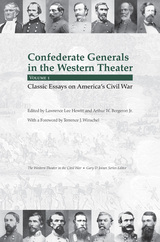
As part of a new series, The Western Theater in the Civil War, this volume reflects the premise that truly understanding the outcome of the war can only be gained through greater knowledge of the western campaigns and the generals who waged them. The essays gathered here—such as Roland’s reassessment of Albert Sidney Johnston, Williams’s examination of P. G. T. Beauregard’s role at Shiloh, Bearss’s look at Bedford Forrest’s great tactical victory at Brice’s Cross Roads, and Vandiver’s analysis of John Bell Hood’s use of logistics—are admirable contributions to this goal. Significantly, in addition to highlighting the Western Theater’s best-known generals, this volume also includes essays on two of its less familiar ones, Patton Anderson and Daniel C. Govan, thus rescuing these fascinating figures from undeserved oblivion.
Future volumes of Confederate Generals in the Western Theater will showcase the latest scholarship with new essays written expressly for the series. By gathering classic earlier work between one set of covers, this opening foray sets a high standard indeed.
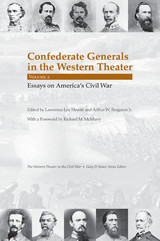
Many students of the Civil War have concluded that the overstudied conflict in the Eastern Theater resulted only in an unwinnable stalemate. For that reason they are now looking to the West for more precise explanations of the Confederates’ failure to win independence. To editors Lawrence Hewitt and Arthur Bergeron, the answers lie with the generals who waged a calamitous war that stretched across nine states and left a long trail of bloody battlefields, surrendered fortresses, burned cities, wrecked infrastructure, and, ultimately, a lost cause.
For this book, which follows an earlier volume of previously published essays, Hewitt and Bergeron have enlisted ten gifted historians—among them James M. Prichard, Terrence J. Winschel, Craig Symonds, and Stephen Davis—to produce original essays, based on the latest scholarship, that examine the careers and missteps of several of the Western Theater’s key Rebel commanders. Among the important topics covered are George B. Crittenden’s declining fortunes in the Confederate ranks, Earl Van Dorn’s limited prewar military experience and its effect on his performance in the Baton Rouge Campaign of 1862, Joseph Johnston’s role in the fall of Vicksburg, and how James Longstreet and Braxton Bragg’s failure to secure Chattanooga paved the way for the Federals’ push into Georgia.
Confederate Generals in the Western Theater will ultimately comprise several volumes that promise a host of provocative new insights into not only the South’s ill-fated campaigns in the West but also the eventual outcome of the larger conflict.
Lawrence Lee Hewitt is professor of history emeritus at Southeastern Louisiana University. A recipient of SLU’s President’s Award for Excellence in Research and the Charles L. Dufour Award for outstanding achievements in preserving the heritage of the American Civil War, he is a former managing editor of North & South. His publications include Port Hudson: Confederate Bastion on the Mississippi.
Arthur W. Bergeron Jr. is a reference historian with the United States Army Military History Institute and a past president of the Louisiana Historical Association. Among his earlier books are Confederate Mobile and A Thrilling Narrative: The Memoir of a Southern Unionist.
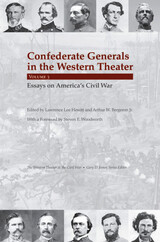
@font-face { font-family: "Times New Roman";}p.MsoNormal, li.MsoNormal, div.MsoNormal { margin: 0in 0in 0.0001pt; line-height: 200%; font-size: 12pt; font-family: Times; }table.MsoNormalTable { font-size: 10pt; font-family: "Times New Roman"; }div.Section1 { page: Section1; }
The American Civil War was won and lost on its western battlefields, but accounts of triumphant Union generals such as Grant and Sherman leave half of the story untold. In the third volume of Confederate Generals in the Western Theater, editors Lawrence Hewitt and Arthur Bergeron bring together ten more never-before-published essays filled with new, penetrating insights into the key question of why the Rebel high command in the West could not match the performance of Robert E. Lee in the East.
Showcasing the work of such gifted historians as Wiley Sword, Timothy B. Smith, Rory T. Cornish, and M. Jane Johansson, this book is a compelling addition to an ongoing, collective portrait of generals who occasionally displayed brilliance but were more often handicapped by both geography and their own shortcomings. While the vast, varied terrain of the Western Theater slowed communications and troop transfers and led to the creation of too many military departments that hampered cooperation among commands, even more damaging were the personal qualities of many of the generals. All too frequently, incompetence, egotism, and insubordination were the rule rather than the exception. Some of these men were undone by alcoholism and womanizing, others by politics and nepotism. A few outlived their usefulness; others were killed before they could demonstrate their potential. Together, they destroyed what chance the Confederacy had of winning its independence.
Whether adding fresh fuel to the debate over the respective roles of Albert Sidney Johnston and P. G. T. Beauregard at Shiloh or bringing to light such lesser known figures as Joseph Finegan and Hiram Bronson Granbury, this volume, like the ones preceding it, is an exemplary contribution to Civil War scholarship.
Lawrence Lee Hewitt is professor of history emeritus at Southeastern Louisiana University. A recipient of SLU’s President’s Award for Excellence in Research and the Charles L. Dufour Award for “outstanding achievements in preserving the heritage of the American Civil War,” he is a former managing editor of North & South. His publications include Port Hudson: Confederate Bastion on the Mississippi.
The late Arthur W. Bergeron Jr. was a reference historian with the United States Army Military History Institute and a past president of the Louisiana Historical Association. Among his earlier books were Confederate Mobile and A Thrilling Narrative: The Memoir of a Southern Unionist.
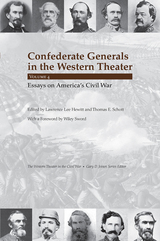
Like its predecessors, the fourth and final volume of Confederate Generals in the Western Theater makes a generous contribution to the historiography of a poorly understood theater of war, presenting new interpretations of major figures while bringing to light both the triumphs and failures of lesser-known generals. Its cutting-edge scholarship offers further grounding for the editors’ contention that the South’s bid for independence was lost on its western battlefields and that the responsibility for those defeats lay more with the Confederate generals than with their opponents.
Among the ten chapters, this collection includes C. David Dalton on the death of Felix Zollicoffer at the Battle of Mill Springs in Kentucky; Roger Durham on Robert E. Lee’s leadership early in the war of the Department of South Carolina, Georgia, and East Florida; Brian S. Wills on Abraham Buford’s behind-the-scenes contributions to Nathan Bedford Forrest’s famous exploits; the late Nathaniel Cheairs Hughes Jr. on the achievements and failings of Gideon J. Pillow; James M. Prichard on John Hunt Morgan and his “last Kentucky raid”; and Keith S. Bohannon on Edward C. Walthall, a Virginia lawyer who overcame his lack of prior military experience to become one of the ablest generals in any of the war’s theaters. Some essays offer full biographies of their subjects; others focus on a single campaign. Along with the previous volumes, this exemplary collection encourages an important rethinking of the course of the Civil War and its ultimate outcome.

Scrupulously edited by Charles Maland, this volume stands as the definitive collection of Agee’s film writing. Not only does it include all of his bylined Nation reviews (December 1942–September 1948), but it also brings together for the first time the entirety of his unsigned reviews and cover stories for Time (September 1942–November 1948), as identified by the magazine’s archivist, Bill Hooper. Also included are various essays Agee produced for other publications—ranging from a prep school appreciation of F. W. Murnau’s The Last Laugh to his celebrated Life magazine pieces on director John Huston and the great comedians of the silent era—as well as several previously unpublished manuscripts found in the Agee collections at the Universities of Tennessee and Texas, which offer additional insight into Agee’s thoughts on movies and on film reviewing.
A constant moviegoer since childhood, Agee wrote about film with wit, keen perception, and high standards, always quick to express disappointment when a movie failed, in his eyes, to live up to what it might have been. But when a movie truly worked for him—William Wellman’s The Story of G. I. Joe, Charles Chaplin’s Monsieur Verdoux, and Huston’s The Treasure of the Sierra Madre are key examples—Agee could be both generous with praise and brimming with insight about the precise features he found so laudable.
Including an extensive introduction that details Agee’s years as a film reviewer, significant characteristics of his style and aesthetic, and his broad influence on later critics, this volume will encourage a fresh understanding of both a remarkable writer and the medium he loved so much.
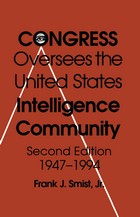
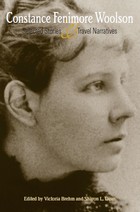
Woolson grew up in Cleveland, Ohio, and began her career writing regional travel stories about the closing of the American frontier in the old Northwest Territories (now known as the Great Lakes region). During the Civil War, she worked for a variety of Union causes and in 1873 moved to St. Augustine, Florida. Traveling throughout the South, she wrote stories and travel narratives that highlighted the wholesale changes facing Americans after the Civil War.
In 1879, Woolson left the United States for Europe. There, she engaged her passion for nature and exercised her gift for social satire. In her European writings, she deplored the Americans’ slavish devotion to the ubiquitous guidebooks of the nineteenth century, and she chose instead to spend long periods of time in one place in order to better learn about it. Throughout her time in Europe (including visits to North Africa), Woolson often commented that she could not describe landscapes, only experience them. By the time of her death in Venice at age fifty-three, she had become convinced that the colonial agendas of the United States and Europe would transform landscapes and peoples in far-reaching and ultimately dangerous ways.
This collection features selections from each of the three distinct periods of Woolson’s career and includes a chronology of her life and travels. Focusing primarily on Woolson’s short stories, editors Victoria Brehm and Sharon L. Dean also include a representative letter, poem, and travel sketch for each section.
Victoria Brehm is associate professor of English at Grand Valley State University. She is editor of three anthologies, including “A Fully Accredited Ocean”: Essays on the Great Lakes and Sweetwater, Storms, and Spirits: Stories of the Great Lakes.
Sharon L. Dean is professor of English at Rivier College and is author of Constance Fenimore Woolson: Homeward Bound and Constance Fenimore Woolson and Edith Wharton: Perspectives on Landscape and Art.

Beginning with a comparison of the American acoustic guitar world in the early 1960s with that of today, then describing iconic performances at storied venues such as The Ark in Ann Arbor while meticulously researching the instrument’s top makers, Smith assembles a passion-filled and eye-opening history of that “cool wooden box” from the folk era through the pandemic. The author focuses on both the playing and making of the acoustic guitar, concluding that the instrument has been transformed in both aspects during the last sixty years. On the playing side, Smith examines the influences on, and the impact of, such guitarists as David Bromberg, Elizabeth Cotten, Paul Geremia, and Norman Blake. On the making side, the author takes the reader into the tradition-minded yet dynamic world of lutherie. He traces how the oldest, most revered companies whose reputations are based on legendary breakthroughs in lutherie, Gibson and Martin, have adapted as the new lutherie movement of innovative small-scale producers, exemplified by interviewees such as Michael Gurian, Bill Collings, Richard Hoover, and Dana Bourgeois, arose. Starting small and then growing exponentially, Taylor Guitars is a wholly different “player” in acoustic guitar building, and Smith compellingly tells its story. Finally, Cool Wooden Box considers the effects of globalization on the industry.
Clocking thousands of miles and hours of interviews with guitar makers, suppliers, and sellers, W. Rand Smith has created not only a detailed history of the acoustic guitar, but also a lasting tribute to an instrument he so clearly reveres.
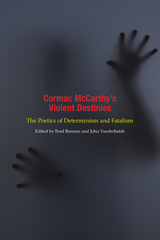
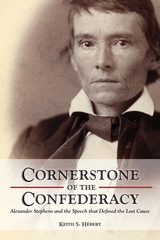
Born in early 1812 in Crawfordville, Georgia, Alexander Stephens grew up in an antebellum South that would one day inform the themes of his famous Cornerstone Speech. While Stephens made many speeches throughout his lifetime, the Cornerstone Speech is the discourse for which he is best remembered. Stephens delivered it on March 21, 1861—one month after his appointment as vice president of the Confederacy—asserting that slavery and white supremacy comprised the cornerstone of the Confederate States of America. Within a few short weeks, more than two hundred newspapers worldwide had reprinted Stephens’s words.
Following the war and the defeat of the Confederacy, Stephens claimed that his assertions in the Cornerstone Speech had been misrepresented, his meaning misunderstood, as he sought to breathe new and different life into an oration that may have otherwise been forgotten. His intentionally ambiguous rhetoric throughout the postwar years obscured his true antebellum position on slavery and its centrality to the Confederate Nation and lent itself to early constructions of Lost Cause mythology.
In Cornerstone of the Confederacy, Keith Hébert examines how Alexander Stephens originally constructed, and then reinterpreted, his well-known Cornerstone Speech. Hébert illustrates the complexity of Stephens’s legacy across eight chronological chapters, meticulously tracing how this speech, still widely cited in the age of Black Lives Matter, reverberated in the nation’s consciousness during Reconstruction, through the early twentieth century, and in debates about commemoration of the Civil War that live on in the headlines today.
Audiences both inside and outside of academia will quickly discover that the book’s implications span far beyond the memorialization of Confederate symbols, grappling with the animating ideas of the past and discovering how these ideas continue to inform the present.
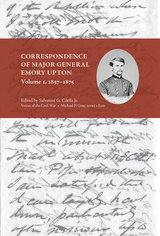
Emory Upton (1839–1881) was thrust into the Civil War immediately upon graduation from the United States Military Academy at West Point in May of 1861. He was wounded three times during the war. He participated in nearly every major battle in the Eastern Theater including Fredericksburg, Gettysburg, and Spotsylvania, where he led a prominent attack on entrenched Confederate positions—a signal of Upton’s brilliance as an officer and of his military creativity that foreshadowed his later work in revising the Army’s tactics. Upton was mustered out of service in 1866 and later named commandant of cadets at West Point, a position that carved a path for Upton to focus more on Army tactics and reforms.
Until now, the only lenses through which scholars could study Upton were two biographies published nearly a century apart but practically identical in scope and treatment. The two-volume Correspondence of Major General Emory Upton follows Upton through his enrollment at West Point to his extensive Army activities following the Civil War and contains the bulk of his wartime correspondence. Volume one, with Upton’s Civil War correspondence encompasses both larger battle details and day-to-day activities in the life of a soldier. His letters reveal a mercurial individual: a humorous person used to suffering and rejoicing, who could be flawed and brilliant, vain and humble.
These selected letters and reports, expertly annotated and gathered from repositories across the country, present a more complex, human Emory Upton. He is both the “clean, pure, and spotless” individual of biographies and the ambitious, yet flawed Army officer obsessed with his career. These volumes explore his trials and frustrations as well as his triumphs.
Salvatore G. Cilella Jr., now retired, was president of the Atlanta Historical Society. He is the author of Upton’s Regulars: The 121st New York Infantry in the American Civil War and Fund Raising for Small Museums in Good Times and Bad.
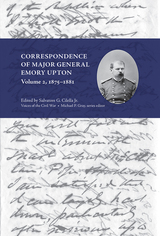
Emory Upton (1839–1881) was thrust into the Civil War immediately upon graduation from the United States Military Academy at West Point in May of 1861. He was wounded three times during the war. He participated in nearly ever major battle in the Eastern Theater including Fredericksburg, Gettysburg, and Spotsylvania, where he led a prominent attack on entrenched Confederate positions—a signal of Upton’s brilliance as an officer and of his military creativity that foreshadowed his later work in revising the Army’s tactics. Upton was mustered out of service in 1866 and later named commandant of cadets at West Point, a position that carved a path for Upton to focus more on Army tactics and reforms.
Until now, the only lenses through which scholars could study Upton were two biographies published nearly a century apart but practically identical in scope and treatment of Upton. The two-volume Correspondence of Major General Emory Upton follows Upton through his enrollment at West Point to his extensive Army activities following the Civil War and contains the bulk of Emory Upton’s wartime correspondence. Volume two collects Upton’s foreign correspondence and observations on military tactics and Army reform. At the behest of U.S. Army Commanding General William T. Sherman, Upton was sent on a tour to study the armies of Asia and Europe, and more specifically the German army after conclusion of the Franco-Prussian War. This tour resulted in the publication of his monumental The Armies of Europe and Asia, which warned that the U.S. Army was woefully below the standards of European nations, and between Upton’s death in 1881 and the turn of the twentieth century, military policy was fiercely debated in both the military and popular press. Upton’s ideas on reform were often central to the arguments, and his letters and writings provoked a wide range of discussion over military and, inevitably, civilian issues.
These selected letters and reports, expertly annotated and gathered from repositories across the country, present a more complex, human Emory Upton. He is both the “clean, pure, and spotless” individual of Michie’s biographies and the ambitious, yet flawed Army officer obsessed with his career. These volumes explore his trials and frustrations as well as his triumphs.
Salvatore G. Cilella, now retired, was president of the Atlanta Historical Society. He is the author of Upton’s Regulars: The 121st New York Infantry in the American Civil War and Fund Raising for Small Museums in Good Times and Bad.
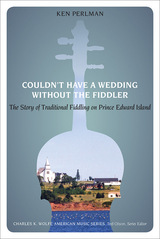
Couldn’t Have a Wedding without the Fiddler draws heavily on interviews conducted with 150 fiddlers and other “Islanders”—including singers, dancers, music instructors, community leaders, and event organizers—whose memories span decades. The book thus colorfully brings to life a time not so very long ago when virtually any occasion—a wedding, harvest, house warming, holiday, or the need to raise money for local institutions such as schools and churchs—was sufficient excuse to hold a dance, with the fiddle player at the center of the celebration. Perlman explores how fiddling skills and traditions were learned and passed down through the generations and how individual fiddlers honed their distinctive playing styles. He also examines the Island’s history and material culture, fiddlers’ values and attitudes, the role of radio and recordings, the fiddlers’ repertoire, fiddling contests, and the ebb and flow of the fiddling tradition, including efforts over the last few decades to keep the music alive in the face of modernization and the passing of “old-timers.” Rounding out the book is a rich array of photographs, musical examples, dance diagrams, and a discography.
The inaugural volume in the Charles K. Wolfe American Music Series, Couldn’t Have a Wedding without the Fiddler is, in the words of series editor Ted Olson, “clearly among the more significant studies of a local North American music tradition to be published in recent years.”
A highly regarded banjoist, guitarist, teacher, and music collector, Ken Perlman previously published a collection of over 400 tunes called The Fiddle Music of Prince Edward Island: Celtic & Acadian Tunes in Living Tradition; he also produced a 2-CD set of field recordings for Rounder Records called The Prince Edward Island Style of Fiddling.. He has written several music instruction manuals now regarded as classics in their field, notably Clawhammer Style Banjo, Melodic Clawhammer Banjo, and Fingerstyle Guitar.
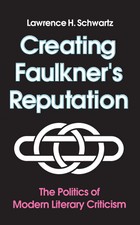
Schwartz traces how the development of New Criticism, a re-evaluation of his work (the difficulty of his style and depraved subject matter, once considered a negative, were now praised), and the publication of THE PORTABLE FAULKNER all went to make him the most respected writer of the 20th Century.
Only about half the book is about Faulkner directly, however; there is also a long chapter on the politics of the new criticism and the intellectual stand of the critics in the 1940s. Some might appreciate this diversion, and much of it is interesting, but for me it went on too long and took away from the main subject of the book. Readers interested in Faulkner's literary career will definitely this book valua
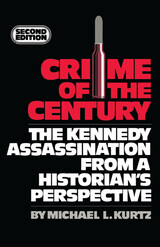
This book recounts the tragic events of November 22, 1963, and provides a detailed critical analysis of the investigations of the Warren Commission and the House Select Committee on Assassinations. Professor Kurtz outlines the major areas of controversy about the assassination and sifts all the known evidence before concluding that both official inquiries failed to evaluate the considerable evidence of an assassination conspiracy. Operating on the a priori assumption that Lee Harvey Oswald was guilty, the Commission and the Committee both ignored and distorted the overwhelming evidence that more than one assassin fired shots at the president. Professor Kurtz also shows why the most prevalent conspiracy theories fail to fit the facts and concludes by offering a new and more plausible theory of how the assassination occurred.
Thoroughly documented and based on the most exhaustive research carried out to date on John Kennedy’s murder, Crime of the Century draws on a variety of primary source materials from the National Archives and the FBI’s and CIA’s declassified assassination files. It utilizes the latest source materials released by the House Select Committee’s investigation. The depth of research, the rigorously objective sifting of evidence, and the incisive critique of official investigative bias make this a book of importance not only to students of the Kennedy assassination in particular, but also to scholars of government response to political violence in general.
Michael L. Kurtz is professor of history at Southeastern Louisiana University, Hammond, Louisiana. He is co-author of LOUISIANA: A HISTORY and was associate editor for READINGS IN LOUISIANA HISTORY.
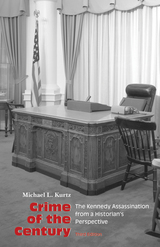
This third edition includes a new introduction, based on updated information about the assassination since the second edition was published in 1993, including material from the National Archives and several major recent interpretations of the events. Drawing on a variety of primary source materials from the National Archives and the FBI’s and CIA’s declassified assassination files, Crime of the Century remains a book of importance not only to students of the Kennedy assassination but also scholars of government response to political violence.

Critical Connections chronicles how Oak Ridge National Laboratory (ORNL), the Y-12 National Security Complex, and their partners became outstanding examples of the military-industrial-educational complex from the Cold War to the present day. At the beginning of the 1950s, Oak Ridge became a flourishing, less-secret city, and the authors show how, decade by decade, ORNL became the source of major breakthroughs in physics, biology, computing, and other fields—and how these achievements required ever-closer connections with UT. By the mid-1990s, after many successful joint initiatives between UT and ORNL, UT was poised to compete to become the manager of ORNL. In 2000, UT-Battelle LLC won the bid from the Department of Energy: UT was charged with providing scientific direction and key personnel; its partner Battelle would oversee ORNL’s operations and chart its technology direction.
The authors highlight the scientific developments these connections have brought, from nanotechnology to nuclear fission, from cryogenic experiments on mice to the world’s fastest supercomputer. The partnerships between a university, a city, and federal facilities helped solve some of the greatest challenges of the twentieth century—and point toward how to deal with those of the twenty-first.
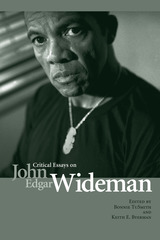

Focusing on several key novels—Nella Larsen’s Quicksand (1928), Lucinda Roy’s Lady Moses (1998), and Danzy Senna’s Caucasia (1998)—as well as memoirs by Obama, James McBride, and Rebecca Walker and the personae of singer Mariah Carey and actress Halle Berry, Dagbovie-Mullins challenges conventional claims about biracial identification with a concept she calls “black-sentient mixed-race identity.” Whereas some multiracial organizations can diminish blackness by, for example, championing the inclusion of multiple-race options on census forms and similar documents, a black-sentient consciousness stresses a perception rooted in blackness—“a connection to a black consciousness,” writes the author, “that does not overdetermine but still plays a large role in one’s racial identification.” By examining the nuances of this concept through close readings of fiction, memoir, and the public images of mixed-race celebrities, Dagbovie-Mullins demonstrates how a “black-sentient mixed-race identity reconciles the widening separation between black/white mixed race and blackness that has been encouraged by contemporary mixed-race politics and popular culture.”
A book that promises to spark new debate and thoughtful reconsiderations of an especially timely topic, Crossing B(l)ack recognizes and investigates assertions of a black-centered mixed-race identity that does not divorce a premodern racial identity from a postmodern racial fluidity.
SIKA A. DAGBOVIE-MULLINS is associate professor in the Department of English at Florida Atlantic University. Her articles have appeared in African American Review, the Journal of Popular Culture, and other publications.
READERS
Browse our collection.
PUBLISHERS
See BiblioVault's publisher services.
STUDENT SERVICES
Files for college accessibility offices.
UChicago Accessibility Resources
home | accessibility | search | about | contact us
BiblioVault ® 2001 - 2024
The University of Chicago Press









